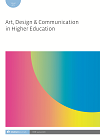
Full text loading...
 , Kieran Mahon1
, Kieran Mahon1
In 2019, the University of the Arts London (UAL) declared a Climate Emergency and undertook to make sustainability a required part of the student learning experience. Subsequently, in 2021, UAL published an anti-racism action plan and declared itself an activist university. These initiatives require educators across UAL’s six constituent colleges – of which Central Saint Martins (CSM) is one – to underpin creative arts learning and teaching with an understanding of global ecologies and societal structures. Since the advent of the COVID-19 pandemic, a considerable amount of this teaching has been delivered online. This case study – based on data gathered from students participating in online workshops – seeks to understand how established teaching practices, such as object-based and experiential learning, can be mobilized to support student understanding of these complex global and societal issues in an online learning environment. We also address the challenges and benefits of teaching art and design subjects using educational technology and ask whether experiential pedagogies can be successfully translated for delivery online.

Article metrics loading...

Full text loading...
References


Data & Media loading...

Publication Date:
https://doi.org/10.1386/adch_00074_1 Published content will be available immediately after check-out or when it is released in case of a pre-order. Please make sure to be logged in to see all available purchase options.